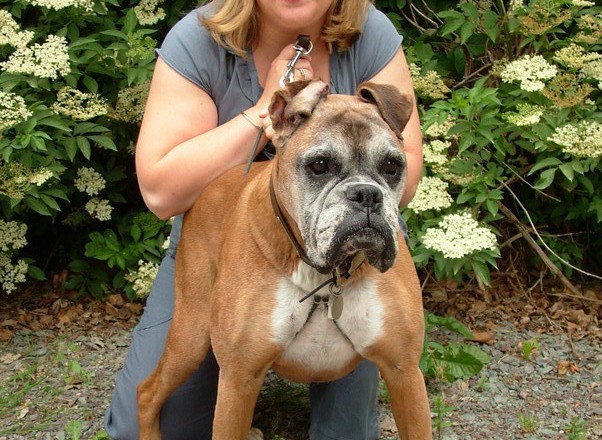
Lameness is very common in pet dogs, and it is much more common in some breeds. Labradors, German Shepherds and Golden Retrievers are examples of breeds that often suffer from creaky joints as they grow older. Boxers, like Ali, tend to be less prone to arthritis, so when Ali was brought in with a lameness problem, I had to keep a very open mind about the possible cause.
Her lameness had started very suddenly, and she had an obvious limp. When she walked up and down in the car park, I could see that she was not putting her full weight on her left hind leg. But which part of her leg was causing her pain? I lifted her up onto the consultation table, and examined her carefully. Dogs cannot tell you where they are hurting, so I had to poke and prod every square inch of her leg to try to discover what was bothering her.
Ali is an easy-going, relaxed dog, and she was quite relaxed as I carried out my examination. I tweaked each of her toes, her ankle, and the rest of her lower leg. She gazed impassively at me, wearing a deadpan, lugubrious expression. I moved further up her leg, firmly squeezing and twisting her knee joint. Ali definitely did not like this. She looked round sharply at me, and her ears twitched – the doggy-equivalent of raising her eyebrows. I tried carrying out the same manipulation of her right knee, and she didn’t budge a bit.
To be sure, I then repeated the tweaking of her left knee, and sure enough, she gave me another disapproving look. I had found the focus of Ali’s problem. I finished my examination by checking her hips and her lower back, but as expected, they were fine. Ali’s lameness was definitely focused in her left knee. The knee is a complex joint. It is held together by numerous ligaments. Many muscles play a role in its movement. And there are multiple components inside it, including cartilage, joint fluid and floating bones. After my examination, I could say with confidence that Ali had a problem with her knee joint, but it was not so easy to say exactly which part of her knee was damaged.
So what next? It is always possible to investigate these problems in more detail. X-ray pictures are a good way of checking the bony structures of the knee. Manipulation under anaesthesia can help to assess the health of the ligaments. Endoscopes can be poked into the joint to visually inspect the various components that might be damaged. And it is even possible to arrange MRI scans for full colour, three-dimensional images of dogs knees.
But Ali was only mildly lame. So how much did I need to do? Many lamenesses are caused by simple injuries, such as the knocks and twists that happen during normal daily life. Ali is a dog who loves her exercise, and she regularly goes on long, energetic walks. It was quite possible that she had simply caused minor damage to her knee by knocking it or twisting it. After discussing the problem with Louise, I decided to give Ali some basic treatment for her lameness first. If she did not get better within a short time, then a full investigation would be the next stage.
The first and most important part of her treatment was simple: rest. In the same way as a twisted ankle in a human will not get better without rest, a sore knee in a dog will not improve if it is being continually stressed. Dogs do not know that they need to rest an injured leg, so their owners need to be the ones to make that decision on their behalf. I told Louise to rest Ali strictly for a full three weeks. She was only to be taken out on short walks, on the lead, for no more than five minutes twice a day. This was a huge cutback from the half-hour twice-daily runs that Ali was used to. I also decided to give Ali some medication. I used a relatively new drug, called “pentosan polysulphate”. This has disease modifying and anti-arthritic properties, helping to heal damaged cartilage in a joint. The drug is given as an injection, once a week for four weeks.
I reviewed Ali’s progress every week, and she made a rapid improvement. By the time of her last injection, her lameness had cleared up completely. It was time to increase her exercise, but in a gradual, careful way. She was kept on lead walks, but for longer distances. She did special “exercises”, such as stepping up and down from pavements as part of her normal walks, to increase her muscle strength. And she did some swimming, which is excellent exercise for dogs that are recovering form injuries.
Ali is now back to her normal lifestyle, with no lameness at all. She is getting older, and she may have more problems with her joints in the future, but so far – so good.
Tips
- ¸ Lameness is very common in older dogs, especially in some breeds
- Strict rest is an important part of treatment of any lame dog
- Modern veterinary drugs help lame dogs recover more rapidly




Comments are closed.
Please note that I am unable to answer veterinary questions in comments. If you have questions or concerns about your pet's health it is always better to contact your vet.